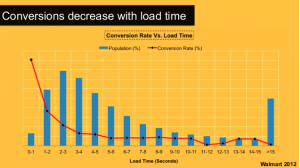The need for customer experience to improve is not a myth. In fact, here’s why. Noted psychology researcher and writer Mihaly Csíkszentmihályi observed in 1998 that people who perform seamless, sequence-based activities on a regular basis are happier than people who don’t[i]. He coined the term “flow” to describe this behavior. With the advent of CoIT, we’ve actually imposed a new set of demands on our customer’s brains. But instead of offering a series of smoothly sequential flows, websites and mobile applications are characterized by lag, downtime, and restarts. And at the same time customer’s flow-oriented brains simply aren’t wired to deal with poor digital experience interactions. Science has shown the business need for great customer experiences is a fact, not a myth.
And it can be tempting to label customers picky and impatient. But there’s a wealth of research on what happens to customers at a neurological level when they are forced to deal with slow or interrupted processes.[i] Their impatience is an indelible part of their human circuitry. Brands must recognize that customers’ hardwiring of the brain’s and their neurological desire for flow and easy of use as part of the cost of doing business. Companies must come to terms with the economic imperative of the customer experience or drive customers to their competitors because of their poor focus on customer experiences.
Fast websites and mobile experience create happier users. Those happier users are more likely to follow “calls to action” to register, download, subscribe, request information, or purchase. Unhappy users, which could include those who experience a mere two-second slowdown in how a web page loads, make almost two percent fewer queries, three point seven-five percent click less often, and report being significantly less satisfied with their overall experience[i]. Worse, they tell their friends about their negative experience. With the word-of-mouth social networks provide, brands need to heed the seriousness of differentiating their brand’s customer experience or be left in the dust.
Response Times have been consistent for 45 years. Based on neuroscience, the facts about human perception and response times have been consistent for more than forty-five years[i]. In fact, these numbers are hard-wired in human brains. And they are consistent regardless of the type of device, application, or connection a customer is using. In fact, that’s key to where customer expectations come from thus important to capitalize on. And what’s critical is determining where a brand’ web / mobile sites compare to customer expectations as well as benchmarking against CoIT applications or competitors or even non-competitors who have a great customer experience.
Response Time Has Not changed Much. In Robert B. Miller’s 1968 paper, “Response Time in Man-Computer Conversational Transactions[ii]“, found people have always been most comfortable, most efficient and most productive with response times of less than two seconds. Since 2006, what has changed slightly is the average online shopper expects pages to load in four seconds or less. Today, forty-nine percent expect page load times of two seconds or less, and eighteen percent expect pages to load instantly[iii]. And while optimizing every aspect of a brand’s digital assets to meet an “instant” expectation is a laudable goal, organizations simply may not have initially budgeted the resources to achieve these goals. Digital experience maturity, however, provides teams the ability to identify the interaction points in the digital customer journey most sensitive to improvement so they can maximize return on performance investment and include this in the budget and resource planning activities. Here’s the results of the Walmart study on page load times and conversion rates:
Businesses can keep arguing that customer experience doesn’t matter, it’s a touchy-feely construct or get it directly affects the bottom-line and start by designing and measuring customer experience performance management. For more on this see my report, here.
@drnatalie petouhoff, VP and Principal Analyst
Covering Customer-Facing Applications
[i] http://www.webperformancetoday.com/2014/07/16/eight-tricks-improve-perce...
[ii]Robert B. Miller’s 1968 paper, “Response Time in Man-Computer Conversational Transactions, https://www.computer.org/csdl/proceedings/afips/1968/5072/00/50720267.pdf
[iii]http://insights.wired.com/profiles/blogs/47-of-consumers-expect-a-web-pa...
[i] http://www.webperformancetoday.com/2010/06/15/everything-you-wanted-to-k....
[i]Dual-task interference in simple tasks: Data and theory. Pashler, Harold Psychological Bulletin, Vol. 116(2), Sep 1994, 220-244. http://dx.doi.org/10.1037/0033-2909.116.2.220
[i] The Concept of Flow: Handbook of Positive Psychology, Nakamura, J. and Csikszentmihayi, M. 2002.



